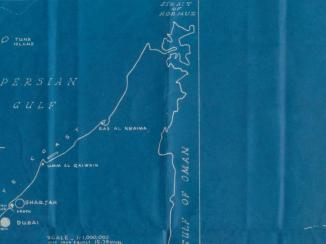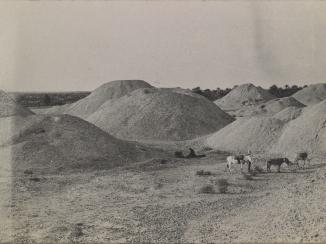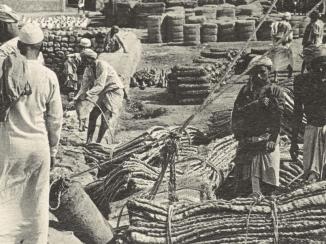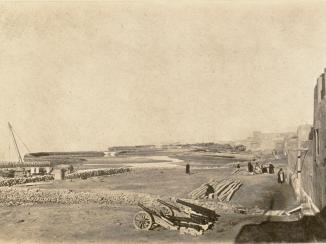Overview
The Kingdom of Saudi Arabia is the second largest Arab state in the world (after Algeria) and has a population of approximately thirty million people. Its capital and largest city is Riyadh, in the country’s centre.
The country forms the bulk of the Arabian Peninsula, stretching from the mountains of the Hejaz that border the Red Sea, across largely inhospitable desert to the oases of the al-Hasa region on the coast of the Persian Gulf The historical term used to describe the body of water between the Arabian Peninsula and Iran. . To the south lie the highlands of Yemen and Oman, a region that has long harboured different cultures and fostered divergent histories. The history of Saudi Arabia is founded on an alliance formed in Najd in 1744 between Muhammad bin Sa‘ūd and Muhammad ibn ‘Abd al-Wahhāb. This alliance, which combined the political skills and capital of the House of Saud with the ideological impetus of Wahhabism, a form of Sunni Islam preached by al-Wahhāb, persists to this day.
!['Vierte Ansicht der Stadt Mekka' [Fourth view of the city of Mecca]. Photographer: al-Sayyid ʻAbd al-Ghaffār, 1886-89. X463/5](https://www.qdl.qa/sites/default/files/styles/standard_content_image/public/x463_0028_cropped.jpg?itok=U8JFX8iA)
This union fuelled Saudi expansion and gave rise to successive periods of Saudi dominance on the Arabian Peninsula throughout the eighteenth- and nineteenth-centuries, curtailed temporarily by the interventions of the Ottoman general, Muhammad Ali Pasha An Ottoman title used after the names of certain provincial governors, high-ranking officials and military commanders. , and the ambitions of a rival Najdi dynasty, Al Rashid.
After a period of decline, the modern Saudi Arabian state grew from the re-establishment of Saudi rule in Riyadh in 1902 by ‘Abd al-‘Azīz Āl Sa‘ūd (popularly known as Ibn Saud). In 1913, he controlled most of Najd and al-Hasa, having taken the latter from the Ottoman Turks. By 1926, he had conquered Hejaz and declared himself King of a territory that spanned the entire Arabian Peninsula. In 1932, Ibn Saud had largely consolidated his domain and in September of that year the modern state of Saudi Arabia was born, by royal proclamation.
In the nineteenth-century, British involvement with the Saudis had been limited to when their maritime interests along the Persian Gulf The historical term used to describe the body of water between the Arabian Peninsula and Iran. were at stake, particularly when the Wahhabi movement seemed to give strength to those tribes the British held responsible for piracy. During the First World War, however, Britain’s imperial and military concerns led them deeper into the affairs of Central Arabia, where Ibn Saud was valued as an ally against the Ottoman Empire.
Britain’s conciliatory approach to Ibn Saud lasted throughout the first half of the twentieth century, with treaties signed in 1915 and 1927. Military and administrative responsibilities in Mandatory Palestine and the new Kingdom of Iraq brought the British into closer intercourse with the Saudi state, especially regarding the definition of borders. This communication was normally conducted through either the Political Agents in Bahrain and Kuwait, or the British representative in Jeddah.
In 1933, the first oil concession in Saudi Arabia was granted to an American company. Five years later, oil was struck in Dhahran, transforming the fortunes and future of the country. Today, according to OPEC, Saudi Arabia holds the second largest oil reserves in the world, and is its largest oil exporter.
Key moments from Saudi Arabia’s history in the India Office Records include
- 1819: George Sadleir becomes the first European to cross the Arabian Peninsula (IOR/R/15/1/21)
- 1865: Lewis Pelly visits Faisal al-Saud in Riyadh (Mss Eur F126/57)
- 1902: Ibn Saud retakes Riyadh from the Al Rashid family (IOR/R/15/1/473)
- 1915: Ibn Saud signs the Treaty of Darin with the British (IOR/R/15/2/32)
- 1927: Ibn Saud signs the Treaty of Jeddah with the British (IOR/R/15/1/574)
- 1929: A rebellion by Ibn Saud’s military wing, the Ikhwan, is put to an end at the Battle of Sabillah (IOR/R/15/1/584)
1932: The modern state of Saudi Arabia is born (IOR/R/15/1/568, folios 57‒58)
Suggested Reading
Askar al-Enazy, The Creation of Saudi Arabia: Ibn Saud and British Imperial Policy, 1914-1927 (London: Routledge, 2010)
Clive Leatherdale, Britain and Saudi Arabia, 1925-1939: The Imperial Oasis (London: Frank Cass, 1983)
Madawi al-Rasheed, A History of Saudi Arabia (Cambridge: Cambridge University Press, 2002)
Alexei Vasiliev, The History of Saudi Arabia (London: Saqi Press, 1998)










